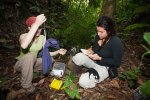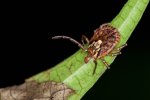Project
Biodiversity and disease risk
Helen Esser studies the relationship between biodiversity loss and the emergence of tick-borne disease emergence, using extensive sampling across a disturbance gradient in Panama.
Biodiversity loss and disease emergence are two of the most pressing environmental issues of our time. I study the relationship between the two, by focusing on the interactions between vertebrates, ticks and pathogens across a wildlife diversity gradient in central Panama.
Project description
Habitat destruction, fragmentation and hunting are among the major drivers of the global biodiversity crisis. An urgent question is how the ongoing loss of species will affect the functioning of ecosystems and the benefits that humans obtain from their natural environment. One such ecosystem service that might be affected is the control of infectious diseases. Loss of wildlife may disrupt complex ecological interactions between pathogens, vectors and hosts, potentially triggering disease emergence in both humans and animals. Hence, a better understanding of how vectors respond to alterations in host community composition and the consequences for pathogen prevalence is critically important.
I study the associations between rickettsias, ticks, and vertebrates, and how wildlife diversity loss affects these interactions. I address this fundamental issue using a community-wide approach; that is, rather than focusing on single-species interactions, I consider broader communities of hosts, ticks and microbes in central Panama. I hypothesize that most tick species in this diverse system are highly host specific in the adult (reproductive) stage, just few are generalists. As a consequence, ticks should be sensitive to coextinction with their hosts. Specifically, specialist ticks should disappear when their specific host species are lost, whereas generalist ticks are able to persist in even the most impoverished wildlife communities. Similarly, the diversity of rickettsias and other microbes - including symbionts and pathogens - should be higher in larger, richer tick communities, and decrease with loss of tick species richness. Although a decrease in tick and microbial diversity with wildlife diversity loss might intuitively sound appealing, most pathogenic microbes are transmitted by generalist ticks. Not only are generalist ticks able to survive in species-poor communities, they may also feed disproportionally more from disease reservoir hosts in such degraded environments, so that increased "generality" of tick communities should increase disease risk.
Fieldwork is carried-out at 20 sites across central Panama that constitute a gradient in wildlife diversity and abundance. I use 1) arrays of motion-sensitive camera traps to assess the community composition of wildlife; 2) drag sampling to collect questing ticks (i.e. those in search of a host); and 3) live trapping of small mammals to directly collect ticks, blood and feces from vertebrate hosts. Using advanced molecular tools, I will identify ticks to species and determine the total microbial diversity within these ticks for each site.
This study will increase fundamental insight into host-tick-pathogen interactions and increase awareness of how anthropogenic disturbance of the natural environment (through wildlife diversity loss) can negatively impact human health.


